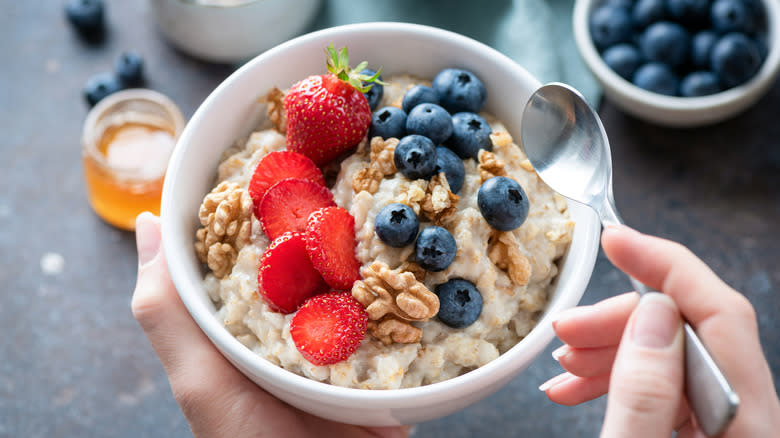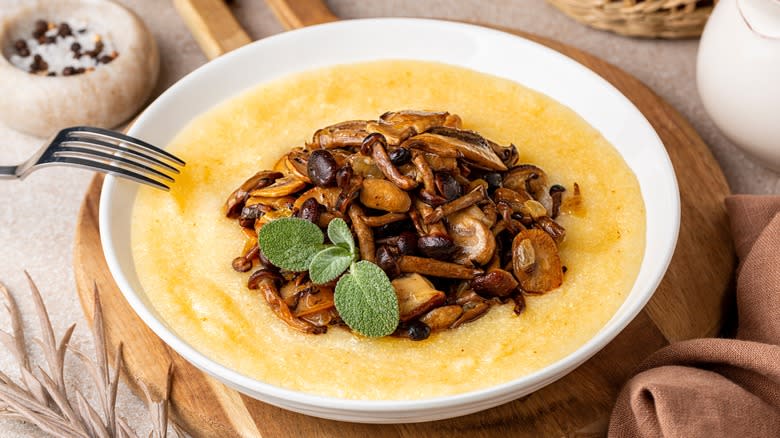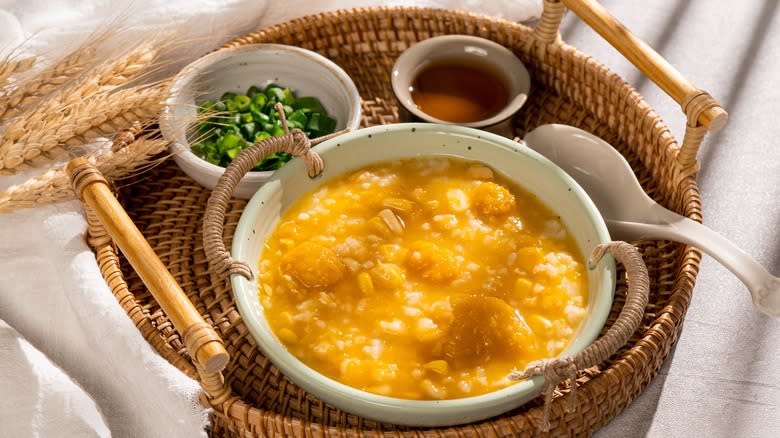Oatmeal Vs Porridge: The Difference Is All In The Oats

Oatmeal and porridge are just perfect for breakfast, offering steady energy throughout the day. But have you ever wondered what makes them different? Just like oatmeal, porridge can be made with oats and milk or water, but you may use legumes or grains like rice, corn, barley, or kasha instead of oats. "Different spices, fruits, and sweetness can be added to this combination according to an individual's taste," performance coach and nutritionist Lily Chapman told Runner's World.
Corn, rice, barley, and other grains or vegetables are not typically used in oatmeal. However, this doesn't mean you must stick to just a few ingredients. Instead, you can experiment with tasty oatmeal toppings like honey, chocolate, peanut butter, orange zest, coconut flakes, or matcha powder. Or, go a step further and add ghee for a buttery flavor.
The main difference between oatmeal and porridge lies in the base ingredient. Apart from that, they're surprisingly similar. In fact, oatmeal is a type of porridge.
Read more: What These Imitation Foods Are Actually Made Of
'Porridge' Is More Of An Umbrella Term

The word "porridge" describes any grain, cereal, or legume boiled in water or milk. Simply put, it's an all-encompassing term for a variety of dishes that are named after their base ingredient. For example, both grits and Cream of Wheat are a kind of porridge, but the former is made from corn and the latter from its eponymous grain. Congee and arroz caldo, on the other hand, are both based on rice.
You can also boil buckwheat in water or milk to make kasha, a type of porridge common in Eastern European countries. But if you're craving Indian food, try your hand at upma, a porridge recipe that calls for coarse rice flour, chiles, veggies, and spices. There's also gugmelsgrød, a type of porridge made from rye meal and topped with jam, whipped cream, and other flavorful ingredients. In Denmark, it's commonly served for dinner. Other countries have žganci (Slovenia and Croatia), polentina (Italy), champurrado (Mexico), or genfo (Ethiopia).
If your porridge uses oats as the main ingredient, it's called oatmeal. You can use rolled oats (also called old-fashioned oats) or steel-cut oats. Steel-cut oats are indeed chopped with metal blades. Rolled oats, meanwhile, are flattened after being steamed.
It's also worth mentioning that both oatmeal and porridge can be sweet or savory. Centuries ago, porridge was served as a savory dish most of the time.
Oatmeal And Porridge Have Different Nutritional Profiles

These breakfast staples also have a different nutritional makeup, depending on the ingredients used. For reference, a cup of cooked oatmeal boasts around 166 calories, nearly 6 grams of protein, more than 3 grams of fat, and 28 grams of carbs. By comparison, a cup of yellow cornmeal, or grits, provides 151 calories, just under 3 grams of protein, almost a gram of fat, and 32 grams of carbs. Cream of Wheat, on the other hand, is lower in calories and fat but higher in iron, calcium, and folate than oatmeal and grits.
Their flavor and texture may differ, too, since oats have a unique consistency. For example, porridge is often made with ground or milled grains, resulting in a smooth, creamy texture. Oatmeal can be soft, chewy, or somewhere in between, depending on the type of oats used. In general, steel-cut oats are coarser than rolled oats, whereas instant oats have a smooth consistency.
Additionally, oatmeal made with 100% oats is gluten-free. This doesn't apply to gugmelsgrød, Cream of Wheat, and other types of porridge. Apart from that, both oatmeal and porridge can be part of a nutritious diet. As Lily Chapman told Runner's World, these comfort foods are rich in protein and fiber, keeping you full for longer. She also noted that dietary fiber feeds the good bacteria in your gut, which may help boost your immune system and keep inflammation at bay.
Read the original article on Daily Meal.

